| Listing 1 - 10 of 12 | << page >> |
Sort by
|
Book
ISBN: 1400881862 Year: 2016 Publisher: Princeton, NJ : Princeton University Press,
Abstract | Keywords | Export | Availability | Bookmark
 Loading...
Loading...Choose an application
- Reference Manager
- EndNote
- RefWorks (Direct export to RefWorks)
This book contains a valuable discussion of renormalization through the addition of counterterms to the Lagrangian, giving the first complete proof of the cancellation of all divergences in an arbitrary interaction. The author also introduces a new method of renormalizing an arbitrary Feynman amplitude, a method that is simpler than previous approaches and can be used to study the renormalized perturbation series in quantum field theory.
Mathematical physics. --- Quantum field theory. --- Addition. --- Adjoint. --- Amplitude. --- Analytic continuation. --- Analytic function. --- Antiparticle. --- C-number. --- Calculation. --- Change of variables. --- Classical electromagnetism. --- Coefficient. --- Commutative property. --- Compact space. --- Complex analysis. --- Complex number. --- Connectivity (graph theory). --- Constant term. --- Convolution. --- Derivative. --- Diagram (category theory). --- Differentiable function. --- Distribution (mathematics). --- Equation. --- Estimation. --- Explicit formulae (L-function). --- Fermion. --- Fock space. --- Formal power series. --- Fourier transform. --- Free field. --- Gauge theory. --- Graph theory. --- Hilbert space. --- Incidence matrix. --- Interaction picture. --- Invertible matrix. --- Irreducibility (mathematics). --- Isolated singularity. --- Lagrangian (field theory). --- Laurent series. --- Mathematical induction. --- Mathematics. --- Momentum. --- Monomial. --- Multiple integral. --- National Science Foundation. --- Notation. --- Parameter. --- Path integral formulation. --- Permutation. --- Polynomial. --- Power series. --- Probability. --- Propagator. --- Quadratic form. --- Quantity. --- Remainder. --- Renormalization. --- Requirement. --- S-matrix. --- Scattering amplitude. --- Scientific notation. --- Second quantization. --- Several complex variables. --- Simple extension. --- Special case. --- Subset. --- Subtraction. --- Suggestion. --- Summation. --- Taylor series. --- Tensor product. --- Theorem. --- Theory. --- Topological space. --- Translational symmetry. --- Tree (data structure). --- Uniform convergence. --- Vacuum expectation value. --- Vacuum state. --- Vacuum. --- Variable (mathematics). --- Vector field. --- Vector potential. --- Wick's theorem. --- Z0.
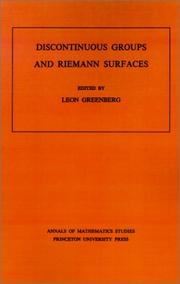
ISBN: 0691081387 1400881641 9780691081380 Year: 1974 Volume: 79 Publisher: Princeton : Princeton University Press,
Abstract | Keywords | Export | Availability | Bookmark
 Loading...
Loading...Choose an application
- Reference Manager
- EndNote
- RefWorks (Direct export to RefWorks)
Study 79 contains a collection of papers presented at the Conference on Discontinuous Groups and Ricmann Surfaces at the University of Maryland, May 21-25, 1973. The papers, by leading authorities, deal mainly with Fuchsian and Kleinian groups, Teichmüller spaces, Jacobian varieties, and quasiconformal mappings. These topics are intertwined, representing a common meeting of algebra, geometry, and analysis.
Group theory --- Complex analysis --- Number theory --- RIEMANN SURFACES --- Discontinuous groups --- congresses --- Congresses --- Riemann surfaces --- Congresses. --- Groupes discontinus --- Combinatorial topology --- Functions of complex variables --- Surfaces, Riemann --- Functions --- Abelian variety. --- Adjunction (field theory). --- Affine space. --- Algebraic curve. --- Algebraic structure. --- Analytic function. --- Arithmetic genus. --- Automorphism. --- Bernhard Riemann. --- Boundary (topology). --- Cauchy sequence. --- Cauchy–Schwarz inequality. --- Cayley–Hamilton theorem. --- Closed geodesic. --- Combination. --- Commutative diagram. --- Commutator subgroup. --- Compact Riemann surface. --- Complex dimension. --- Complex manifold. --- Complex multiplication. --- Complex space. --- Complex torus. --- Congruence subgroup. --- Conjugacy class. --- Convex set. --- Cyclic group. --- Degeneracy (mathematics). --- Diagram (category theory). --- Diffeomorphism. --- Differential form. --- Dimension (vector space). --- Disjoint sets. --- E7 (mathematics). --- Endomorphism. --- Equation. --- Equivalence class. --- Euclidean space. --- Existence theorem. --- Existential quantification. --- Finite group. --- Finitely generated group. --- Fuchsian group. --- Fundamental domain. --- Fundamental lemma (Langlands program). --- Fundamental polygon. --- Galois extension. --- Holomorphic function. --- Homeomorphism. --- Homology (mathematics). --- Homomorphism. --- Hurwitz's theorem (number theory). --- Inclusion map. --- Inequality (mathematics). --- Inner automorphism. --- Intersection (set theory). --- Irreducibility (mathematics). --- Isomorphism class. --- Isomorphism theorem. --- Jacobian variety. --- Jordan curve theorem. --- Kleinian group. --- Limit point. --- Mapping class group. --- Metric space. --- Monodromy. --- Monomorphism. --- Möbius transformation. --- Non-Euclidean geometry. --- Orthogonal trajectory. --- Permutation. --- Polynomial. --- Power series. --- Projective variety. --- Quadratic differential. --- Quadric. --- Quasi-projective variety. --- Quasiconformal mapping. --- Quotient space (topology). --- Rectangle. --- Riemann mapping theorem. --- Riemann surface. --- Schwarzian derivative. --- Simply connected space. --- Simultaneous equations. --- Special case. --- Subgroup. --- Subsequence. --- Surjective function. --- Symmetric space. --- Tangent space. --- Teichmüller space. --- Theorem. --- Topological space. --- Topology. --- Uniqueness theorem. --- Unit disk. --- Variable (mathematics). --- Winding number. --- Word problem (mathematics). --- RIEMANN SURFACES - congresses --- Discontinuous groups - Congresses --- Geometrie algebrique --- Fonctions d'une variable complexe --- Surfaces de riemann
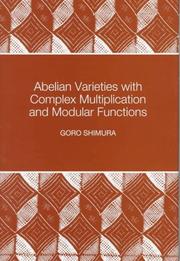
ISBN: 0691016569 1400883946 9780691016566 Year: 2016 Volume: 46 Publisher: Princeton, NJ : Princeton University Press,
Abstract | Keywords | Export | Availability | Bookmark
 Loading...
Loading...Choose an application
- Reference Manager
- EndNote
- RefWorks (Direct export to RefWorks)
Reciprocity laws of various kinds play a central role in number theory. In the easiest case, one obtains a transparent formulation by means of roots of unity, which are special values of exponential functions. A similar theory can be developed for special values of elliptic or elliptic modular functions, and is called complex multiplication of such functions. In 1900 Hilbert proposed the generalization of these as the twelfth of his famous problems. In this book, Goro Shimura provides the most comprehensive generalizations of this type by stating several reciprocity laws in terms of abelian varieties, theta functions, and modular functions of several variables, including Siegel modular functions. This subject is closely connected with the zeta function of an abelian variety, which is also covered as a main theme in the book. The third topic explored by Shimura is the various algebraic relations among the periods of abelian integrals. The investigation of such algebraicity is relatively new, but has attracted the interest of increasingly many researchers. Many of the topics discussed in this book have not been covered before. In particular, this is the first book in which the topics of various algebraic relations among the periods of abelian integrals, as well as the special values of theta and Siegel modular functions, are treated extensively.
Ordered algebraic structures --- 512.74 --- Abelian varieties --- Modular functions --- Functions, Modular --- Elliptic functions --- Group theory --- Number theory --- Varieties, Abelian --- Geometry, Algebraic --- Algebraic groups. Abelian varieties --- 512.74 Algebraic groups. Abelian varieties --- Abelian varieties. --- Modular functions. --- Abelian extension. --- Abelian group. --- Abelian variety. --- Absolute value. --- Adele ring. --- Affine space. --- Affine variety. --- Algebraic closure. --- Algebraic equation. --- Algebraic extension. --- Algebraic number field. --- Algebraic structure. --- Algebraic variety. --- Analytic manifold. --- Automorphic function. --- Automorphism. --- Big O notation. --- CM-field. --- Characteristic polynomial. --- Class field theory. --- Coefficient. --- Complete variety. --- Complex conjugate. --- Complex multiplication. --- Complex number. --- Complex torus. --- Corollary. --- Degenerate bilinear form. --- Differential form. --- Direct product. --- Direct proof. --- Discrete valuation ring. --- Divisor. --- Eigenvalues and eigenvectors. --- Embedding. --- Endomorphism. --- Existential quantification. --- Field of fractions. --- Finite field. --- Fractional ideal. --- Function (mathematics). --- Fundamental theorem. --- Galois extension. --- Galois group. --- Galois theory. --- Generic point. --- Ground field. --- Group theory. --- Groupoid. --- Hecke character. --- Homology (mathematics). --- Homomorphism. --- Identity element. --- Integer. --- Irreducibility (mathematics). --- Irreducible representation. --- Lie group. --- Linear combination. --- Linear subspace. --- Local ring. --- Modular form. --- Natural number. --- Number theory. --- Polynomial. --- Prime factor. --- Prime ideal. --- Projective space. --- Projective variety. --- Rational function. --- Rational mapping. --- Rational number. --- Real number. --- Residue field. --- Riemann hypothesis. --- Root of unity. --- Scientific notation. --- Semisimple algebra. --- Simple algebra. --- Singular value. --- Special case. --- Subgroup. --- Subring. --- Subset. --- Summation. --- Theorem. --- Vector space. --- Zero element.
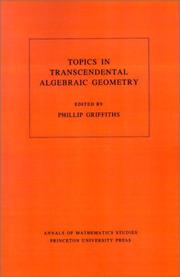
ISBN: 0691083355 0691083398 140088165X Year: 1984 Publisher: Princeton (N.J.): Princeton university press
Abstract | Keywords | Export | Availability | Bookmark
 Loading...
Loading...Choose an application
- Reference Manager
- EndNote
- RefWorks (Direct export to RefWorks)
The description for this book, Topics in Transcendental Algebraic Geometry. (AM-106), Volume 106, will be forthcoming.
Geometry, Algebraic. --- Hodge theory. --- Torelli theorem. --- Géométrie algébrique --- Théorie de Hodge --- Geometry, Algebraic --- Hodge theory --- Torelli theorem --- 512.7 --- Torelli's theorem --- Curves, Algebraic --- Jacobians --- Complex manifolds --- Differentiable manifolds --- Homology theory --- Algebraic geometry --- Geometry --- Algebraic geometry. Commutative rings and algebras --- 512.7 Algebraic geometry. Commutative rings and algebras --- Géométrie algébrique --- Théorie de Hodge --- Abelian integral. --- Algebraic curve. --- Algebraic cycle. --- Algebraic equation. --- Algebraic geometry. --- Algebraic integer. --- Algebraic structure. --- Algebraic surface. --- Arithmetic genus. --- Arithmetic group. --- Asymptotic analysis. --- Automorphism. --- Base change. --- Bilinear form. --- Bilinear map. --- Cohomology. --- Combinatorics. --- Commutative diagram. --- Compactification (mathematics). --- Complete intersection. --- Complex manifold. --- Complex number. --- Computation. --- Deformation theory. --- Degeneracy (mathematics). --- Differentiable manifold. --- Dimension (vector space). --- Divisor (algebraic geometry). --- Divisor. --- Elliptic curve. --- Elliptic surface. --- Equation. --- Exact sequence. --- Fiber bundle. --- Function (mathematics). --- Fundamental class. --- Geometric genus. --- Geometry. --- Hermitian symmetric space. --- Hodge structure. --- Homology (mathematics). --- Homomorphism. --- Homotopy. --- Hypersurface. --- Intersection form (4-manifold). --- Intersection number. --- Irreducibility (mathematics). --- Isomorphism class. --- Jacobian variety. --- K3 surface. --- Kodaira dimension. --- Kronecker's theorem. --- Kummer surface. --- Kähler manifold. --- Lie algebra bundle. --- Lie algebra. --- Linear algebra. --- Linear algebraic group. --- Line–line intersection. --- Mathematical induction. --- Mathematical proof. --- Mathematics. --- Modular arithmetic. --- Module (mathematics). --- Moduli space. --- Monodromy matrix. --- Monodromy theorem. --- Monodromy. --- Nilpotent orbit. --- Normal function. --- Open set. --- Period mapping. --- Permutation group. --- Phillip Griffiths. --- Point at infinity. --- Pole (complex analysis). --- Polynomial. --- Projective space. --- Pullback (category theory). --- Quadric. --- Regular singular point. --- Resolution of singularities. --- Riemann–Roch theorem for surfaces. --- Scientific notation. --- Set (mathematics). --- Special case. --- Spectral sequence. --- Subgroup. --- Submanifold. --- Surface of general type. --- Surjective function. --- Tangent bundle. --- Theorem. --- Topology. --- Transcendental number. --- Vector space. --- Zariski topology. --- Zariski's main theorem.
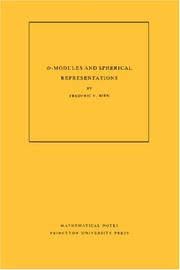
ISBN: 1400862078 9781400862078 0691025177 9780691608327 9780691025179 0691025177 0691608326 9780691608327 Year: 1990 Publisher: Princeton, New Jersey
Abstract | Keywords | Export | Availability | Bookmark
 Loading...
Loading...Choose an application
- Reference Manager
- EndNote
- RefWorks (Direct export to RefWorks)
The theory of D-modules deals with the algebraic aspects of differential equations. These are particularly interesting on homogeneous manifolds, since the infinitesimal action of a Lie algebra consists of differential operators. Hence, it is possible to attach geometric invariants, like the support and the characteristic variety, to representations of Lie groups. By considering D-modules on flag varieties, one obtains a simple classification of all irreducible admissible representations of reductive Lie groups. On the other hand, it is natural to study the representations realized by functions on pseudo-Riemannian symmetric spaces, i.e., spherical representations. The problem is then to describe the spherical representations among all irreducible ones, and to compute their multiplicities. This is the goal of this work, achieved fairly completely at least for the discrete series representations of reductive symmetric spaces. The book provides a general introduction to the theory of D-modules on flag varieties, and it describes spherical D-modules in terms of a cohomological formula. Using microlocalization of representations, the author derives a criterion for irreducibility. The relation between multiplicities and singularities is also discussed at length.Originally published in 1990.The Princeton Legacy Library uses the latest print-on-demand technology to again make available previously out-of-print books from the distinguished backlist of Princeton University Press. These editions preserve the original texts of these important books while presenting them in durable paperback and hardcover editions. The goal of the Princeton Legacy Library is to vastly increase access to the rich scholarly heritage found in the thousands of books published by Princeton University Press since its founding in 1905.
Differentiable manifolds. --- D-modules. --- Representations of groups. --- Lie groups. --- Groups, Lie --- Lie algebras --- Symmetric spaces --- Topological groups --- Group representation (Mathematics) --- Groups, Representation theory of --- Group theory --- Modules (Algebra) --- Differential manifolds --- Manifolds (Mathematics) --- Affine space. --- Algebraic cycle. --- Algebraic element. --- Analytic function. --- Annihilator (ring theory). --- Automorphism. --- Banach space. --- Base change. --- Big O notation. --- Bijection. --- Bilinear form. --- Borel subgroup. --- Cartan subalgebra. --- Cofibration. --- Cohomology. --- Commutative diagram. --- Commutative property. --- Commutator subgroup. --- Complexification (Lie group). --- Conjugacy class. --- Coproduct. --- Coset. --- Cotangent space. --- D-module. --- Derived category. --- Diagram (category theory). --- Differential operator. --- Dimension (vector space). --- Direct image functor. --- Discrete series representation. --- Disk (mathematics). --- Dot product. --- Double coset. --- Eigenfunction. --- Eigenvalues and eigenvectors. --- Endomorphism. --- Euler operator. --- Existential quantification. --- Fibration. --- Function space. --- Functor. --- G-module. --- Gelfand pair. --- Generic point. --- Hilbert space. --- Holomorphic function. --- Homomorphism. --- Hyperfunction. --- Ideal (ring theory). --- Infinitesimal character. --- Inner automorphism. --- Invertible sheaf. --- Irreducibility (mathematics). --- Irreducible representation. --- Levi decomposition. --- Lie algebra. --- Line bundle. --- Linear algebraic group. --- Linear space (geometry). --- Manifold. --- Maximal compact subgroup. --- Maximal torus. --- Metric space. --- Module (mathematics). --- Moment map. --- Morphism. --- Noetherian ring. --- Open set. --- Presheaf (category theory). --- Principal series representation. --- Projective line. --- Projective object. --- Projective space. --- Projective variety. --- Reductive group. --- Riemannian geometry. --- Riemann–Hilbert correspondence. --- Right inverse. --- Ring (mathematics). --- Root system. --- Satake diagram. --- Sheaf (mathematics). --- Sheaf of modules. --- Special case. --- Sphere. --- Square-integrable function. --- Sub"ient. --- Subalgebra. --- Subcategory. --- Subgroup. --- Summation. --- Surjective function. --- Symmetric space. --- Symplectic geometry. --- Tensor product. --- Theorem. --- Triangular matrix. --- Vector bundle. --- Volume form. --- Weyl group.
Book
ISBN: 140088280X Year: 2016 Publisher: Princeton, NJ : Princeton University Press,
Abstract | Keywords | Export | Availability | Bookmark
 Loading...
Loading...Choose an application
- Reference Manager
- EndNote
- RefWorks (Direct export to RefWorks)
In this, one of the first books to appear in English on the theory of numbers, the eminent mathematician Hermann Weyl explores fundamental concepts in arithmetic. The book begins with the definitions and properties of algebraic fields, which are relied upon throughout. The theory of divisibility is then discussed, from an axiomatic viewpoint, rather than by the use of ideals. There follows an introduction to p-adic numbers and their uses, which are so important in modern number theory, and the book culminates with an extensive examination of algebraic number fields. Weyl's own modest hope, that the work "will be of some use," has more than been fulfilled, for the book's clarity, succinctness, and importance rank it as a masterpiece of mathematical exposition.
Algebraic number theory. --- Abelian group. --- Absolute value. --- Abstract algebra. --- Addition. --- Additive group. --- Adjunction (field theory). --- Algebra. --- Algebraic equation. --- Algebraic function. --- Algebraic manifold. --- Algebraic number field. --- Algebraic number theory. --- Algebraic number. --- Algebraic operation. --- Algebraic surface. --- Algebraic theory. --- An Introduction to the Theory of Numbers. --- Analytic function. --- Automorphism. --- Axiomatic system. --- Bernhard Riemann. --- Big O notation. --- Calculation. --- Class number. --- Coefficient. --- Commutative property. --- Commutative ring. --- Complex number. --- Cyclic group. --- Cyclotomic field. --- Dimension. --- Direct product. --- Dirichlet series. --- Discriminant. --- Divisibility rule. --- Division algebra. --- Divisor. --- Entire function. --- Equation. --- Euler function. --- Existential quantification. --- Finite field. --- Fractional ideal. --- Functional equation. --- Fundamental theorem of algebra. --- Galois group. --- Galois theory. --- Geometry. --- Ground field. --- Hermann Weyl. --- Ideal number. --- Identity matrix. --- Infinite product. --- Integer. --- Irreducibility (mathematics). --- Irreducible polynomial. --- Lattice (group). --- Legendre symbol. --- Linear map. --- Logarithm. --- Mathematics. --- Meromorphic function. --- Modular arithmetic. --- Multiplicative group. --- Natural number. --- Nth root. --- Number theory. --- P-adic number. --- Polynomial. --- Prime factor. --- Prime ideal. --- Prime number theorem. --- Prime number. --- Prime power. --- Principal ideal. --- Quadratic equation. --- Quadratic field. --- Quadratic form. --- Quadratic reciprocity. --- Quadratic residue. --- Real number. --- Reciprocity law. --- Riemann surface. --- Ring (mathematics). --- Ring of integers. --- Root of unity. --- S-plane. --- Scientific notation. --- Sign (mathematics). --- Special case. --- Square number. --- Subgroup. --- Summation. --- Symmetric function. --- Theorem. --- Theoretical physics. --- Theory of equations. --- Theory. --- Variable (mathematics). --- Vector space.
Book
ISBN: 0691645442 1400869269 Year: 2015 Publisher: Princeton, NJ : Princeton University Press,
Abstract | Keywords | Export | Availability | Bookmark
 Loading...
Loading...Choose an application
- Reference Manager
- EndNote
- RefWorks (Direct export to RefWorks)
This volume offers a systematic treatment of certain basic parts of algebraic geometry, presented from the analytic and algebraic points of view. The notes focus on comparison theorems between the algebraic, analytic, and continuous categories.Contents include: 1.1 sheaf theory, ringed spaces; 1.2 local structure of analytic and algebraic sets; 1.3 Pn 2.1 sheaves of modules; 2.2 vector bundles; 2.3 sheaf cohomology and computations on Pn; 3.1 maximum principle and Schwarz lemma on analytic spaces; 3.2 Siegel's theorem; 3.3 Chow's theorem; 4.1 GAGA; 5.1 line bundles, divisors, and maps to Pn; 5.2 Grassmanians and vector bundles; 5.3 Chern classes and curvature; 5.4 analytic cocycles; 6.1 K-theory and Bott periodicity; 6.2 K-theory as a generalized cohomology theory; 7.1 the Chern character and obstruction theory; 7.2 the Atiyah-Hirzebruch spectral sequence; 7.3 K-theory on algebraic varieties; 8.1 Stein manifold theory; 8.2 holomorphic vector bundles on polydisks; 9.1 concluding remarks; bibliography.Originally published in 1974.The Princeton Legacy Library uses the latest print-on-demand technology to again make available previously out-of-print books from the distinguished backlist of Princeton University Press. These editions preserve the original texts of these important books while presenting them in durable paperback and hardcover editions. The goal of the Princeton Legacy Library is to vastly increase access to the rich scholarly heritage found in the thousands of books published by Princeton University Press since its founding in 1905.
Geometry, Algebraic --- Geometry, Analytic --- Additive map. --- Affine variety. --- Algebraic curve. --- Algebraic geometry. --- Algebraic operation. --- Algebraic surface. --- Algebraic variety. --- Analytic continuation. --- Analytic set. --- Analytic space. --- Atiyah–Hirzebruch spectral sequence. --- Automorphism. --- Bott periodicity theorem. --- Cauchy's integral formula. --- Chern class. --- Chow's theorem. --- Codimension. --- Coherence condition. --- Cohomology operation. --- Cohomology ring. --- Cohomology. --- Cokernel. --- Commutative diagram. --- Comparison theorem. --- Complex manifold. --- Complex vector bundle. --- De Rham cohomology. --- Diagram (category theory). --- Differentiable manifold. --- Differential form. --- Differential geometry. --- Differential topology. --- Dimension (vector space). --- Divisor (algebraic geometry). --- Divisor. --- Duality (mathematics). --- Epimorphism. --- Equation. --- Exact sequence. --- Fiber bundle. --- Fundamental class. --- General linear group. --- Grassmannian. --- Group homomorphism. --- Hilbert's syzygy theorem. --- Holomorphic function. --- Holomorphic sheaf. --- Holomorphic vector bundle. --- Homomorphism. --- Homotopy group. --- Homotopy. --- Irreducibility (mathematics). --- Isomorphism class. --- Jacobian matrix and determinant. --- K-theory. --- Laurent series. --- Lie derivative. --- Line bundle. --- Linear map. --- Manifold. --- Mathematical induction. --- Measure (mathematics). --- Meromorphic function. --- Module (mathematics). --- Morphism. --- Neighbourhood (mathematics). --- Obstruction theory. --- Polynomial. --- Power series. --- Presheaf (category theory). --- Principal bundle. --- Product topology. --- Projective space. --- Projective variety. --- Resolution of singularities. --- Riemann surface. --- Ring (mathematics). --- Ring homomorphism. --- Schwarz lemma. --- Sheaf (mathematics). --- Sheaf cohomology. --- Sheaf of modules. --- Simplicial complex. --- Special case. --- Spectral sequence. --- Stein manifold. --- Submanifold. --- Subset. --- Surjective function. --- Tangent bundle. --- Tangent space. --- Tensor algebra. --- Theorem. --- Topological space. --- Topology. --- Transcendence degree. --- Variable (mathematics). --- Vector bundle. --- Weierstrass preparation theorem. --- Zariski topology.
Book
ISBN: 1400882435 Year: 2016 Publisher: Princeton, NJ : Princeton University Press,
Abstract | Keywords | Export | Availability | Bookmark
 Loading...
Loading...Choose an application
- Reference Manager
- EndNote
- RefWorks (Direct export to RefWorks)
This book is concerned with two areas of mathematics, at first sight disjoint, and with some of the analogies and interactions between them. These areas are the theory of linear differential equations in one complex variable with polynomial coefficients, and the theory of one parameter families of exponential sums over finite fields. After reviewing some results from representation theory, the book discusses results about differential equations and their differential galois groups (G) and one-parameter families of exponential sums and their geometric monodromy groups (G). The final part of the book is devoted to comparison theorems relating G and G of suitably "corresponding" situations, which provide a systematic explanation of the remarkable "coincidences" found "by hand" in the hypergeometric case.
Exponential sums. --- Differential equations. --- Adjoint representation. --- Algebraic geometry. --- Algebraic integer. --- Algebraically closed field. --- Automorphism. --- Base change. --- Bernard Dwork. --- Big O notation. --- Bijection. --- Calculation. --- Characteristic polynomial. --- Codimension. --- Coefficient. --- Cohomology. --- Comparison theorem. --- Complex manifold. --- Conjugacy class. --- Connected component (graph theory). --- Convolution. --- Determinant. --- Diagram (category theory). --- Differential Galois theory. --- Differential equation. --- Dimension (vector space). --- Dimension. --- Direct sum. --- Divisor. --- Eigenvalues and eigenvectors. --- Endomorphism. --- Equation. --- Euler characteristic. --- Existential quantification. --- Exponential sum. --- Fiber bundle. --- Field of fractions. --- Finite field. --- Formal power series. --- Fourier transform. --- Fundamental group. --- Fundamental representation. --- Galois extension. --- Galois group. --- Gauss sum. --- Generic point. --- Group theory. --- Homomorphism. --- Hypergeometric function. --- Identity component. --- Identity element. --- Integer. --- Irreducibility (mathematics). --- Irreducible representation. --- Isogeny. --- Isomorphism class. --- L-function. --- Laurent polynomial. --- Lie algebra. --- Logarithm. --- Mathematical induction. --- Matrix coefficient. --- Maximal compact subgroup. --- Maximal torus. --- Mellin transform. --- Monic polynomial. --- Monodromy theorem. --- Monodromy. --- Monomial. --- Natural number. --- Normal subgroup. --- P-adic number. --- Permutation. --- Polynomial. --- Prime number. --- Pullback. --- Quotient group. --- Reductive group. --- Regular singular point. --- Representation theory. --- Ring homomorphism. --- Root of unity. --- Scientific notation. --- Set (mathematics). --- Sheaf (mathematics). --- Special case. --- Subcategory. --- Subgroup. --- Subring. --- Subset. --- Summation. --- Surjective function. --- Symmetric group. --- Tensor product. --- Theorem. --- Theory. --- Three-dimensional space (mathematics). --- Torsor (algebraic geometry). --- Trichotomy (mathematics). --- Unitarian trick. --- Unitary group. --- Variable (mathematics).
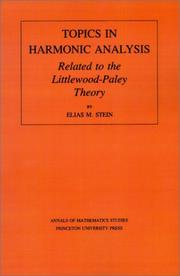
ISBN: 0691080674 1400881870 9780691080673 Year: 1970 Volume: 63 Publisher: Princeton : Princeton University Press,
Abstract | Keywords | Export | Availability | Bookmark
 Loading...
Loading...Choose an application
- Reference Manager
- EndNote
- RefWorks (Direct export to RefWorks)
This work deals with an extension of the classical Littlewood-Paley theory in the context of symmetric diffusion semigroups. In this general setting there are applications to a variety of problems, such as those arising in the study of the expansions coming from second order elliptic operators. A review of background material in Lie groups and martingale theory is included to make the monograph more accessible to the student.
Harmonic analysis. Fourier analysis --- Harmonic analysis --- Semigroups --- 517.986.6 --- Lie groups --- Littlewood-Paley theory --- #WWIS:d.d. Prof. L. Bouckaert/BOUC --- Fourier analysis --- Functions of several real variables --- Group theory --- Groups, Lie --- Lie algebras --- Symmetric spaces --- Topological groups --- Analysis (Mathematics) --- Functions, Potential --- Potential functions --- Banach algebras --- Calculus --- Mathematical analysis --- Mathematics --- Bessel functions --- Fourier series --- Harmonic functions --- Time-series analysis --- Harmonic analysis of functions of groups and homogeneous spaces --- Harmonic analysis. --- Littlewood-Paley theory. --- Lie groups. --- Semigroups. --- 517.986.6 Harmonic analysis of functions of groups and homogeneous spaces --- Addition. --- Analytic function. --- Axiom. --- Boundary value problem. --- Central limit theorem. --- Change of variables. --- Circle group. --- Classification theorem. --- Commutative property. --- Compact group. --- Complex analysis. --- Convex set. --- Coset. --- Covering space. --- Derivative. --- Differentiable manifold. --- Differential geometry. --- Differential operator. --- Dimension (vector space). --- Dimension. --- Direct sum. --- E6 (mathematics). --- E7 (mathematics). --- E8 (mathematics). --- Elementary proof. --- Equation. --- Equivalence class. --- Existence theorem. --- Existential quantification. --- Fourier analysis. --- Fourier series. --- Fourier transform. --- Function space. --- General linear group. --- Haar measure. --- Harmonic function. --- Hermite polynomials. --- Hilbert transform. --- Homogeneous space. --- Homomorphism. --- Ideal (ring theory). --- Identity matrix. --- Indecomposability. --- Integral transform. --- Invariant measure. --- Invariant subspace. --- Irreducibility (mathematics). --- Irreducible representation. --- Lebesgue measure. --- Legendre polynomials. --- Lie algebra. --- Lie group. --- Linear combination. --- Linear map. --- Local diffeomorphism. --- Markov process. --- Martingale (probability theory). --- Matrix group. --- Measurable function. --- Measure (mathematics). --- Multiple integral. --- Normal subgroup. --- One-dimensional space. --- Open set. --- Ordinary differential equation. --- Orthogonality. --- Orthonormality. --- Parseval's theorem. --- Partial differential equation. --- Probability space. --- Quadratic form. --- Rank of a group. --- Regular representation. --- Riemannian manifold. --- Riesz transform. --- Schur orthogonality relations. --- Scientific notation. --- Semigroup. --- Sequence. --- Special case. --- Stone–Weierstrass theorem. --- Sturm–Liouville theory. --- Subgroup. --- Subset. --- Summation. --- Tensor algebra. --- Tensor product. --- Theorem. --- Theory. --- Topological group. --- Topological space. --- Torus. --- Trigonometric polynomial. --- Trivial representation. --- Uniform convergence. --- Unitary operator. --- Unitary representation. --- Vector field. --- Vector space. --- Lie, Groupes de --- Analyse harmonique
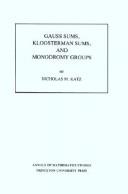
ISBN: 0691084335 0691084327 1400882125 Year: 1988 Volume: vol 116 Publisher: Princeton : Princeton University Press,
Abstract | Keywords | Export | Availability | Bookmark
 Loading...
Loading...Choose an application
- Reference Manager
- EndNote
- RefWorks (Direct export to RefWorks)
The study of exponential sums over finite fields, begun by Gauss nearly two centuries ago, has been completely transformed in recent years by advances in algebraic geometry, culminating in Deligne's work on the Weil Conjectures. It now appears as a very attractive mixture of algebraic geometry, representation theory, and the sheaf-theoretic incarnations of such standard constructions of classical analysis as convolution and Fourier transform. The book is simultaneously an account of some of these ideas, techniques, and results, and an account of their application to concrete equidistribution questions concerning Kloosterman sums and Gauss sums.
Group theory --- Algebraic geometry --- Number theory --- 511.33 --- Analytical and multiplicative number theory. Asymptotics. Sieves etc. --- 511.33 Analytical and multiplicative number theory. Asymptotics. Sieves etc. --- Gaussian sums --- Homology theory --- Kloosterman sums --- Monodromy groups --- Kloostermann sums --- Sums, Kloosterman --- Sums, Kloostermann --- Exponential sums --- Cohomology theory --- Contrahomology theory --- Algebraic topology --- Gauss sums --- Sums, Gaussian --- Analytical and multiplicative number theory. Asymptotics. Sieves etc --- Gaussian sums. --- Kloosterman sums. --- Homology theory. --- Monodromy groups. --- Number theory. --- Nombres, Théorie des. --- Exponential sums. --- Sommes exponentielles. --- Arithmetic --- Arithmétique --- Geometry, Algebraic. --- Géométrie algébrique --- Abelian category. --- Absolute Galois group. --- Absolute value. --- Additive group. --- Adjoint representation. --- Affine variety. --- Algebraic group. --- Automorphic form. --- Automorphism. --- Big O notation. --- Cartan subalgebra. --- Characteristic polynomial. --- Classification theorem. --- Coefficient. --- Cohomology. --- Cokernel. --- Combination. --- Commutator. --- Compactification (mathematics). --- Complex Lie group. --- Complex number. --- Conjugacy class. --- Continuous function. --- Convolution theorem. --- Convolution. --- Determinant. --- Diagonal matrix. --- Dimension (vector space). --- Direct sum. --- Dual basis. --- Eigenvalues and eigenvectors. --- Empty set. --- Endomorphism. --- Equidistribution theorem. --- Estimation. --- Exactness. --- Existential quantification. --- Exponential sum. --- Exterior algebra. --- Faithful representation. --- Finite field. --- Finite group. --- Four-dimensional space. --- Frobenius endomorphism. --- Fundamental group. --- Fundamental representation. --- Galois group. --- Gauss sum. --- Homomorphism. --- Integer. --- Irreducibility (mathematics). --- Isomorphism class. --- Kloosterman sum. --- L-function. --- Leray spectral sequence. --- Lie algebra. --- Lie theory. --- Maximal compact subgroup. --- Method of moments (statistics). --- Monodromy theorem. --- Monodromy. --- Morphism. --- Multiplicative group. --- Natural number. --- Nilpotent. --- Open problem. --- P-group. --- Pairing. --- Parameter space. --- Parameter. --- Partially ordered set. --- Perfect field. --- Point at infinity. --- Polynomial ring. --- Prime number. --- Quotient group. --- Representation ring. --- Representation theory. --- Residue field. --- Riemann hypothesis. --- Root of unity. --- Sheaf (mathematics). --- Simple Lie group. --- Skew-symmetric matrix. --- Smooth morphism. --- Special case. --- Spin representation. --- Subgroup. --- Support (mathematics). --- Symmetric matrix. --- Symplectic group. --- Symplectic vector space. --- Tensor product. --- Theorem. --- Trace (linear algebra). --- Trivial representation. --- Variable (mathematics). --- Weil conjectures. --- Weyl character formula. --- Zariski topology.
| Listing 1 - 10 of 12 | << page >> |
Sort by
|

 Search
Search Feedback
Feedback About
About Help
Help News
News